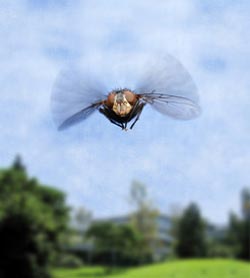How the Fly Flies

Flies are excellent flyers. However, without the gene spalt they stay on the ground and walk.<br>Picture: Frank Schnorrer / Copyright: MPI of Biochemistry<br>
Scientists at the Max Planck Institute (MPI) of Biochemistry in Martinsried near Munich, Germany, recently identified the genetic switch that regulates the formation of flight muscles. “The gene spalt is essential for the generation of the ultrafast super muscles,” emphasizes Frank Schnorrer, head of the research group “Muscle Dynamics”. “Without spalt, the fly builds only normal leg muscles instead of flight muscles.” The scientists’ results have now been published in Nature.
In order to fly efficiently, flies have to flap their small wings very fast. This causes the familiar buzzing and humming of the small beasts. The fruit fly Drosophila melanogaster moves her wings at a frequency of 200 hertz – that means its flight muscles contract and relax 200 times per second. “In contrast, a hundred meters sprinter who moves his legs only a few times per second moves like a snail,” Frank Schnorrer describes. How can the fruit fly flap its wings at such a high frequency?
Muscles control all body movements, including the wing oscillations. However, flight muscles are unique. Their contractions are not only regulated by nerve impulses as usual, but additionally triggered by tension. Every fly has two categories of flight muscles which enable the wing oscillations: One type moves the wings down and, at the same time, stretches the other type which induces its contraction. Such, the wings are pulled up again and stable wing oscillations begin.
No spalt, you are flightless
By means of targeted gene silencing in the fruit fly, scientists in the research group “Muscle Dynamics” at the MPI of Biochemistry have now identified the switch essential for the formation of flight muscles: Spalt. Transcription factors like Spalt play an important role for the correct transcription of the genetic information into RNA and proteins necessary in the respective cell type. Spalt only exists in flight muscles and is responsible for the specific architecture of their myofibrils. These components of muscle fibers alone enable the contraction of a muscle in response to the applied tension during the oscillations. Without Spalt, the flies survive, but are flightless. The flight muscles no longer react to tension and behave like normal leg muscles. Vice versa, the scientists succeeded in creating flight muscle-like muscles in the fly’s legs by only inserting Spalt.
These results could be medically important. “Human body muscles do not have Spalt and are hardly regulated by tension,” Frank Schnorrer explains. “But the human cardiac muscle builds Spalt and the tension inside the ventricle influences the heartbeat intensity. Whether Spalt plays a role in heartbeat regulation, is not yet known and remains to be investigated.” [UD]
Original Publication
Cornelia Schönbauer, Jutta Distler, Nina Jährling, Martin Radolf, Hans-Ulrich Dodt, Manfred Frasch & Frank Schnorrer (2011): Spalt mediates an evolutionarily conserved switch to fibrillar muscle fate in insects. Nature, November 17, 2011.
DOI: 10.1038/nature10559.
Contact
Dr. Frank Schnorrer
Muscle Dynamics
Max Planck Institute of Biochemistry
Am Klopferspitz 18
82152 Martinsried
E-Mail: schnorrer@biochem.mpg.de
http://www.biochem.mpg.de/schnorrer
Anja Konschak
Public Relations
Max Planck Institute of Biochemistry
Am Klopferspitz 18
82152 Martinsried
Tel. +49 (0) 89 8578-2824
E-Mail: konschak@biochem.mpg.de
Media Contact
More Information:
http://www.biochem.mpg.deAll latest news from the category: Life Sciences and Chemistry
Articles and reports from the Life Sciences and chemistry area deal with applied and basic research into modern biology, chemistry and human medicine.
Valuable information can be found on a range of life sciences fields including bacteriology, biochemistry, bionics, bioinformatics, biophysics, biotechnology, genetics, geobotany, human biology, marine biology, microbiology, molecular biology, cellular biology, zoology, bioinorganic chemistry, microchemistry and environmental chemistry.
Newest articles

Properties of new materials for microchips
… can now be measured well. Reseachers of Delft University of Technology demonstrated measuring performance properties of ultrathin silicon membranes. Making ever smaller and more powerful chips requires new ultrathin…

Floating solar’s potential
… to support sustainable development by addressing climate, water, and energy goals holistically. A new study published this week in Nature Energy raises the potential for floating solar photovoltaics (FPV)…

Skyrmions move at record speeds
… a step towards the computing of the future. An international research team led by scientists from the CNRS1 has discovered that the magnetic nanobubbles2 known as skyrmions can be…





















